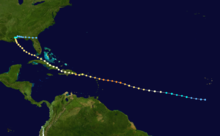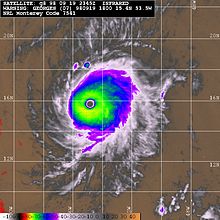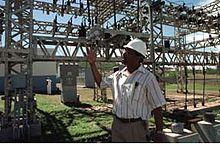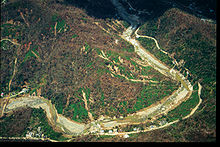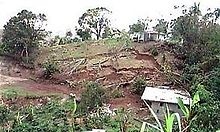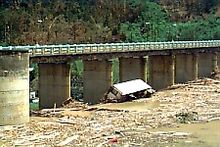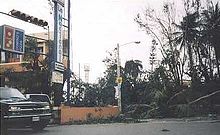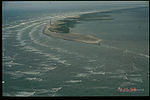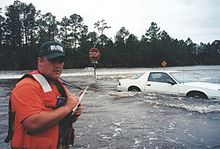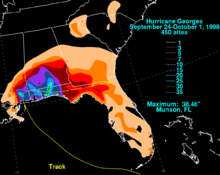
Hurricane Georges
About this schools Wikipedia selection
SOS Children have produced a selection of wikipedia articles for schools since 2005. Visit the SOS Children website at http://www.soschildren.org/
| Category 4 hurricane ( SSHS) | |
|---|---|
 |
|
| Georges as a Category 4 hurricane | |
| Formed | September 15, 1998 |
| Dissipated | October 1, 1998 |
| Highest winds | 1-minute sustained: 155 mph (250 km/h) |
| Lowest pressure | 937 mbar ( hPa); 27.67 inHg |
| Fatalities | 604 direct |
| Damage | $5.9 billion (1998 USD) |
| Areas affected | Leeward Islands, Puerto Rico, Dominican Republic, Haiti, Cuba, Florida Keys, Mississippi, Alabama, Southeastern Louisiana, Florida Panhandle |
| Part of the 1998 Atlantic hurricane season | |
Hurricane Georges (pron.: / ˈ ʒ ɔr ʒ /) was a powerful and long-lived Cape Verde-type Category 4 hurricane which caused severe destruction as it traversed the Caribbean and Gulf of Mexico in September 1998, making seven landfalls along its path. Georges was the seventh tropical storm, fourth hurricane, and second major hurricane of the 1998 Atlantic hurricane season. It became the second most destructive storm of the season after Hurricane Mitch and the costliest Atlantic hurricane since Hurricane Andrew in 1992. Georges killed 604 people, mainly on the island of Hispaniola, and caused extensive damage resulting at nearly $6 billion (1998 US dollars, $8.45 billion 2013 USD) in damages mostly in St. Kitts and Nevis, Puerto Rico and Hispaniola.
The hurricane made landfall in at least seven different countries (Antigua and Barbuda, St. Kitts and Nevis, Haiti, the Dominican Republic, Cuba and the United States) and Puerto Rico, a Commonwealth of the United States — more than any other hurricane since Hurricane Inez of the 1966 season.
Meteorological history
A tropical wave exited the coast of Africa on September 13. Moving westward, the large system quickly developed a closed circulation, and was classified Tropical Depression Seven on September 15. A strong upper-level ridge forced the depression to the west-northwest, where warm water temperatures allowed it to strengthen to a tropical storm on September 16. Georges's circulation developed strong banding features around a well-organized Central Dense Overcast, and with the aid of a developing anti-cyclone, Georges attained hurricane status late on September 17.
Conditions became nearly ideal for continued development, including warm water temperatures, low-level inflow to the hurricane's north, and good upper-level outflow. A banding eye developed, and Georges reached major hurricane strength on September 19 while 675 mi (1085 km) east-southeast of Guadeloupe. By September 19, an upper-level anticyclone was well established over Georges and satellite pictures suggested that the hurricane was beginning to strengthen rapidly, as indicated by the cooling cloud tops, increased symmetry of the deep convection, and the warming and contracting of the well-defined 40 mi (63 km) wide eye as rapid intensification continued, and Georges peaked at a very dangerous Category 4 storm with 155 mph (250 km/h) wind and a 937 minimal pressure late on September 19 and early September 20. At that time, Georges was the most intense, strongest storm since Hurricane Hugo and alongside Hurricane Luis, it is one of the largest major hurricanes in the Atlantic with hurricane force windfields extending more than 150 mi (250 km) from the centre and with a more than 300 mi (490 km) wide tropical storm force windfield. Shortly after peaking, upper-level wind shear from the development of an upper-level low weakened the hurricane on September 20 in the afternoon, as the central pressure had risen 26 mb as Georges approached the Leeward Islands.
On September 21, after weakening considerably, Category 3 Georges made landfall directly on Antigua and three hours later in St. Kitts, though its 175 mi (280 km) wide tropical storm force windfield affected all the Leeward Islands. After weakening to a Category 2 hurricane over the Caribbean, upper-level shear decreased, and Georges strengthened a bit before making landfall near Fajardo, Puerto Rico as a 115 mph (175 km/h) Category 3 hurricane later that day. Over the mountainous terrain of the island, the hurricane weakened again, but over the Mona Passage it again re-intensified to hit eastern Dominican Republic with winds of 120 mph (195 km/h) on September 22. Like in Puerto Rico, Georges was greatly weakened by the mountainous terrain, and after crossing the Windward Passage, it struck 30 mi (48 km) east of Guantánamo Bay, Cuba on September 23. Well-defined upper-level outflow allowed the hurricane to remain well organized, and while paralleling the northern coastline of the island Georges retained minimal hurricane status.
Hurricane Georges reached the Straits of Florida on September 24, and as it had done earlier in its lifetime, quickly restrengthened to Category 2 status on the September 25 due to warm water temperatures and little upper-level shear. It continued to the west-northwest, and struck Key West later on September 25 with winds of 105 mph (165 km/h). Despite moving over warmer water, Georges only managed to peak at 110 mph (175 km/h) in the Gulf of Mexico, likely due to its disrupted inner core. A mid-tropospheric anticyclone pushed the hurricane slowly north-northwestward, forcing Georges to make its seventh and final landfall near Biloxi, Mississippi on September 28. Within 24 hours, Georges had weakened to a tropical depression, and due to weak steering currents the storm looped over southern Mississippi, then drifted to the east. The weak circulation moved eastward over the interior of the Florida Panhandle, and dissipated on October 1 near the Florida/ Georgia border.
Preparations
Lesser Antilles
Late on September 18, a hurricane watch was issued for Saint Lucia, Anguilla, Saba, and Sint Maarten; it was extended to include the British and United States Virgin Islands on the following day. Later on September 19, a hurricane warning was put into effect for islands between Dominica and Anguilla, as well as Saint Martin, but excluding Saint Barthélemy. Early on the following day, a tropical storm warning was issued for Saint Lucia and Martinique. About six hours later, the hurricane warning issued on September 19 was extended on September 20 to include islands north and west of Dominica until Puerto Rico. Simultaneously, the tropical storm warning in effect for Saint Lucia and Martinique was discontinued. By later on September 21, the hurricane warning was canceled for all islands east of the Virgin Islands including Antigua, Barbuda, St. Barthelemy, St. Martin. At 0300 UTC on the following day, the hurricane warning was extended to include the British and United States Virgin Islands, though six hours later, it was also discontinued.
Several hundred people on the island of Montserrat went into twelve hurricane shelters as Georges passed by with winds of 110 mph (175 km/h). On September 18, the National Disaster Preparedness Committee in Dominica began meetings to prepare for possible impacts from Georges. Residents began stocking up on supplies by this time. For the following two days, the island was placed under a state of high-alert as direct impact from a Category 4 hurricane was anticipated. By the following morning, most businesses had boarded up their windows and roads were quiet. Officials declared that schools would be closed on September 21 and shelters across the island were opened.
Puerto Rico
In the days prior to the hurricane's arrival, thousands of citizens in the Leeward Islands and Puerto Rico prepared for the major hurricane by boarding windows and purchasing supplies. Puerto Rican governor Pedro Rosselló activated the island's National Guard, opened 416 shelters, and enacted a temporary prohibition on alcohol sales. More than 28,000 people across the island evacuated their homes to the shelters in the northern portion of the island. Both the Federal Emergency Management Agency (FEMA) and the American Red Cross deployed workers there with supplies for a potentially deadly event. The National Hurricane Centre issued hurricane warnings for the island 37 hours prior to Hurricane Georges's landfall.
Hispaniola
Due to initial forecasts of the hurricane brushing the northern portion of the country, the Dominican Republic was caught off guard. Instead, like in Puerto Rico, Georges traversed the entire country, and passed close to Santo Domingo. Neighboring Haiti expected the worst, opening shelters and evacuating vulnerable people from low-lying coastal areas.
Cuba
Prior to making landfall, more than 200,000 people were evacuated from coastal areas in eastern Cuba. In the potentially impacted area, Cuba's revolutionary army was sent to farm lands to harvest crops that could be destroyed during the storm. Members of the Cuban government travelled door-to-door to alert everyone of the hurricane. In addition to this, President Fidel Castro spoke live on national television to explain the country's plans to withstand the hurricane, as well as ensuring a quick recovery effort by using all of the nation's resources. The Cuban Government issued Hurricane Warnings 30½ hours prior to landfall.
United States
Initial forecasts of a southeastern Florida landfall forced over 1.2 million to evacuate, including much of the Florida Keys. Despite the mandatory evacuation order, 20,000 people, including over 7,000 Key West citizens, refused to leave. Some of those who remained to ride out the storm were shrimpers, whose boats were their entire livelihood. Insurance companies refused to insure some of the older shrimp boats, leading shrimpers to ride it out with all they had left. Due to lack of law enforcement, those who stayed in Key West went through red lights, double-parked, and disobeyed traffic laws. Long-time Florida Keys citizens noted the solitude of the time and enjoyed the island for how it once was, rather than the large crowds of tourists.
In the northern Gulf of Mexico, Georges was forecast to attain major hurricane status and make landfall in southeastern Louisiana. Because of this, portions of the state were evacuated, including New Orleans. There, the Louisiana Superdome was, for the first time in its history, used as a refuge of last resort for those unable to evacuate New Orleans. More than 14,000 citizens rode out the storm in the facility, causing difficulties to supply necessities. The building had no problems related to the weather, though evacuees looted the building, stole furniture, and damaged property. However, the damage was much less than in the aftermath of Hurricane Katrina in 2005. Many citizens in southern Mississippi were told to leave due to a mandatory or recommended evacuation. Of those in the evacuation area, 60% actually left. Most of those who stayed remained because they believed their house was safe enough for the storm. Of those who left, most went to a relative's house in their own county. Prior to making landfall, Georges's track was very uncertain. This forced for the mandatory evacuations of Alabama's two coastal counties, Baldwin and Mobile Counties, with a combined population of over 500,000 people. Despite the order, only 67% of the area actually left to a safer place. Most of those who remained stayed because they believed their house would be able to withstand the hurricane. The majority of those who did leave went to a relative's house in a safer portion of the state. In the days before making landfall, only 22% of the population in recommended evacuation areas along the Florida Panhandle actually left. However, most of them were prepared to leave if the situation became worse. Those who did leave were concerned about the severity of the storm, while those who stayed felt their home was safe enough for the hurricane's effects. Floridians who evacuated typically left for a friend or relative's house, and only went to another area of their county.
Impact
| Country | State | Deaths | Damage | Ref |
|---|---|---|---|---|
|
|
3 | $59.4 million | ||
|
|
0 | $20 million | ||
|
|
5 | $800 million | ||
|
|
0 | $9.4 million | ||
|
|
380 | $2 billion | ||
|
|
209 | $179 million | ||
|
|
1 | Unknown | ||
|
|
6 | $306 million | ||
| United States | U.S. Virgin Islands | 0 | $3.6 billion | |
| Puerto Rico | 7 | |||
| Alabama | 1 | $2.77 billion | ||
| Florida | 0 | |||
| Georgia | 0 | |||
| Louisiana | 3 | |||
| Mississippi | 0 | |||
| Total | 604 | $9.72 billion | ||
A large and long-lasting hurricane, Hurricane Georges brought torrential rainfall and mudslides along much of its path through the Greater Antilles. In all, the hurricane caused $5.9 billion (1998 USD, $8 billion 2010 USD) in damage to the United States and its possessions, and resulted in 604 fatalities. In the two months after Georges's final landfall, the American Red Cross spent $104 million (1998 USD, $150 million 2009 USD) on relief aid through Puerto Rico, the U.S. Virgin Islands, Florida, Louisiana, Alabama, and Mississippi, making Georges the costliest disaster aid in the program's 125-year history.
Leeward Islands
Upon moving through the Leeward Islands, Georges brought strong winds and heavy rainfall, amounting to a maximum of 7.5 inches (190 mm) at St. John.
Antigua
In Antigua, strong winds caused severe property damage, mostly caused to roofs. 10-20% of houses were greatly impacted, including three schools. High winds during the passage of the hurricane downed telephone and power lines, causing loss of communication and power across much of the island. Between Barbuda and Antigua, Georges killed 3 people, left 3,800 homeless and resulting at $160 million damage.
Guadeloupe
The weakening hurricane spared the island as it passed 25 miles (40 km) to the north, causing moderate damage (houses and roofs, uprooted trees, power lines and outages, beach erosion) especially in Grande-Terre. In Basse-Terre, minor to moderate damage was common; the worst damage was to the banana crops, 85% to 100% devastated, with a cost of 100 millions of francs (22 millions USD). The maximal rainfall was 5 to 6 inches in this area.
The Met office in Desirade, east of Guadeloupe had a 75 miles per hour (121 km/h) wind and a 88 miles per hour (142 km/h) sustained gust. In Raizet, they experienced a 42 miles per hour (68 km/h) wind and a maximal gust 66 miles per hour (106 km/h). The minimal pressure fell to 1000 mb (29.54 IHg) for several hours.
Météo France forecast 12–24 hours before a 65 mph winds with gust near 100 mph and a minimal pressure around 980 mb, meaning the worst has been avoid.
St. Kitts and Nevis
After passing through Antigua, Georges produced strong winds of up to 115 mph (185 km/h) while passing over St. Kitts, Georges caused catastrophic damage downing power lines, telephone lines, and trees across the island. Lack of electricity resulted in damage to water facilities, as well. Georges's high winds caused extensive property damage, damaging 80-85% of the houses on the island, and destroying 20-25% of homes. Many schools, businesses, hospitals, and government buildings lost their roofs, while the airport experienced severe damage to its main terminal and control tower, limiting flights to the daytime. St. Kitts' economy was disrupted from severe agricultural losses, including the devastation of 50% of their sugar crop. In addition, damaged hotels and piers created a long-term impact through lack of tourism — an industry the island relies on. In all, Hurricane Georges caused 5 fatalities, left 3,000 homeless, and resulted in $458 million (1998 USD) in damage on the island.
In the other part of the country, Nevis fared better. Like on St. Kitts, high winds downed power and telephone lines, damaging the water system there. 35% of homes on the island were damaged, though none were destroyed. Rainfall and debris killed several hundred livestock and seriously damaged coconut trees, amounting to $2.5 million (1998 USD) in agricultural damage. There were no casualties reported on the island, and damaged amounted to $39 million (1998 USD).
Damage in St. Kitts totaled EC$1.2 billion (US$458 million). Total damage on Nevis amounted to $39 million. The total damage from the storm was nearly twice the country's Gross Domestic Product of US$271 million.
British Virgin Islands
No major damage was reported to public buildings in the British Virgin Islands. Some of the islands' homes had roofs blown off. The environment suffered major damage. There were many reports of eroded soil in areas where construction was in progress. Some of the soils were planted on roads in mangrove farms and in the sea, which could have potentially killed sea life. National Parks around the islands suffered minor damage except for Queen Elizabeth Park, which had many fallen trees. None of the schools in the area suffered any damage and opened again four days after Georges had passed. There were no fatalities in the islands and one minor injury was reported. There was no major damage to the islands' medical buildings. Pipe damage was found in two areas, but there was no damage to the sewage systems. The total damage in the British Virgin Islands was valued at US$9.404 million.
U.S. Virgin Islands
As Georges moved through the northern end of the Lesser Antilles, it produced significant rainfall and strong winds over the United States Virgin Islands. Maximum rainfalls reached 6.79 inches (172 mm) at the airport in St. Croix and 5.26 inches (134 mm) at St. Thomas Airport. The strongest sustsinaed winds and gusts were recorded on St. Croix as well, measuring 74 mph (119 km/h) and 91 mph (146 km/h) respectively. A total of 20 homes were destroyed and 50 others sustained damage. Most of the losses were confined to agriculture and livestock. Fifty-five boats were sunk across the islands. Several power lines were downed throughout St. Croix by high winds, leaving some residences without power. However, compared to the intensity of Georges during its passage of the islands, relatively few people, 15% of the island's customers, lost power. This was due to the improved power grid set up across the island for this type of event. Total losses on the island were estimated at $2 million (1998 USD).
In other nearby islands, Georges impact was relatively minor to moderate. Power outages, flooding, and minor to moderate structural damage was common.
Puerto Rico
On making landfall, Georges brought a 10 foot (3 m) storm surge, along with 20 foot (6 m) waves on top of it. The hurricane spawned 2 F2 tornadoes on the island, though they caused little damage. Georges dropped immense precipitation in the mountain regions, amounting to a maximum of 30.51 inches (775 mm) in Jayuya with many other locations reporting over 1 foot (300 mm). The mountain flooding drained off in the island's rivers, causing every river to overflow its banks. Near the coast, the surfeit of water carved new channels from the record discharge rate. The storm's strong winds caused beach erosion in many places along the coastline. Eroded beaches, flooding, and debris left many roads impassable or destroyed, isolating some villages on the western portion of the island. Over 22,000 people were sheltered in 139 shelters in cities throughout the island. All experienced power outages, and after the storm passed through, lack of water and sewer systems was a serious problem.
Hurricane Georges was the first hurricane to cross the entire island since the San Ciprian Hurricane in 1932. Its large circulation brought fierce winds to the entire island, damaging 72,605 houses and destroying 28,005 homes. This left tens of thousands homeless after the storm's passage. High winds downed nearly half of the island's electric and telephone lines, leaving 96% of the population powerless and 8.4% of telephone customers without service. Lack of electricity greatly damaged the water system, resulting in the loss of water and sewer service for 75% of the island. Georges's deluge of rainfall caused significant damage to the agricultural industry, including the loss of 75% of its coffee crop, 95% of its banana or plantain crop, and 65% of its live poultry.
Luis Muñoz Marín International Airport recorded a 69 knots sustained wind and a 81 knots sustained gust and a 979.7 mb lowest pressure. The lowest recorded was in Roosevelt Roads Naval Station with 971.4 mb while the highest sustained wind and gust reported at an official site was 78 knots and 93 knots, respectively, at 2302 UTC 21 September. One of the most important observations reported was in Fajardo, Puerto Rico where the Civil Defense office measured a sustained wind of 96 knots with gusts to 113 knots at 2130 UTC 21 September and a 983.1 mb.
In all, Hurricane Georges caused $1.9 billion in damage (1998 USD, $2.75 billion 2009 USD), but due to well-executed warnings there were no reported casualties.
In the nearby small island of Culebra, Georges destroyed 74 houses and damaged 89 others, although damage estimates are not available there.
Hispaniola
Though there are no recorded amounts, satellite-derived rainfall estimates show up to 39 inches (990 mm) of rain falling in the mountainous terrain of the countries. This heavy rainfall resulted in mudslides and flooding, killing a total of 589 people across the island and leaving more than 350.000 homeless.
Dominican Republic
In the Dominican Republic, Georges brought strong winds and very heavy rains, along with a 7 foot (2 m) storm surge. Nearly 10 hours of continuous rainfall resulted in mudslides and overflown rivers across the mountainous country, damaging many cities along the southern coastline, including the capital. 120 mph (193 km/h) winds downed and uprooted trees across much of the country, littering streets with debris and mud. Thousands of houses were destroyed, while many were completely destroyed from the flooding and winds. The entire country was without electricity during the aftermath of the storm, damaging water and communication systems. Heavy wind damage and flooding caused extensive damage to the airport in Santo Domingo, restricting usage to military and non-commercial flights.
Most impacted by Hurricane Georges was the agricultural industry. The areas hardest hit by the hurricane coincided with the country's main crop-growing areas, including the provinces around Santo Domingo. After a severe drought in 1997, extreme rainfall damaged around 470,000 acres (190,202 ha) of food crops, including various types of vegetables, fruits, and roots — some of the country's main diet food. Substantial amounts of tobacco and sugar plantations, the country's most important export crop, were severely damaged. The extreme flooding caused great losses in the poultry industry, an important economy in the area. The Dominican Republic had to import significant amounts of rice and other crops to compensate for the losses.
Death toll reports were slow in the wake of the storm, but a total of 380 people died from Hurricane Georges. Damage in the Dominican Republic amounted to $1.2 billion (1998 USD, $1.8 billion 2009 USD).
Haiti
Upon reaching Haiti, Georges was a weakened hurricane, but it still brought heavy rainfall across the entire country. The capital city of Port-au-Prince was largely unharmed, with the exception of flooding in low-lying coastal areas, damaging the main commercial port. The rest of the country, however, experienced a significant number of mudslides due to deforestation along the mountains. These mudslides destroyed or severely damaged many houses, leaving 167,332 homeless. Damage was greatest along the northern coastline from Cap-Haïtien to Gonaïves due to the flooding and mudslides. On the southern coast, the head of a U.S.-based medical team, stranded for several days by flooding in the remote town of Belle Anse, anticipated a rise in malnutrition, disease, homelessness and poverty. Lack of electricity led to a total disruption of Haiti's water supply system, causing a decrease in sanitary conditions across the poorest country in the Western Hemisphere. In all, 209 people died in Haiti.
Like in the Dominican Republic, the agricultural sector suffered extreme damage. After a severe drought in 1997, Georges's severe flooding stopped any chances of recovering quickly. Most of the country's significant crop land, including Artibonite Valley, suffered total losses. Up to 80% of banana plantations were lost, while vegetable, roots, tubers, and other food crops were ruined. In addition, thousands of small farm animals were either killed or lost. Total agricultural losses amounted to $179 million (1998 USD, $250 million 2009 USD). The country requested food assistance in the aftermath of the hurricane to alleviate the serious losses.
Cuba
Upon making landfall, Hurricane Georges produced torrential rainfall, amounting to a maximum of 24.41 inches (620 mm) at Limonar in the province of Guantánamo. Several other locations reported over a foot (300 mm) of precipitation as well. Storm surge of 4 – 6 feet (1 – 2 m) was expected along the eastern coastline, along with dangerous waves on top of the surge. Though winds were reduced by the time Georges hit Cuba, it still retained winds of 75 mph (121 km/h), along with stronger gusts in squalls.
The hurricane's heavy rainfall resulted in mudslides along the mountainous terrain. This, combined with strong winds, damaged 60,475 homes, of which 3,481 were completely destroyed. In the country, 100,000 were left homeless due to Hurricane Georges. High winds downed power lines, trees, and telephone poles, leaving many in eastern Cuba without electricity in the aftermath of the storm. Along the coast, severe flooding washed out railroad and highway bridges. Though eastern Cuba was the area most affected, the central and western portion of the island, including Havana, experienced torrential rains and strong wind gusts. There, strong waves broke over the seawall, and caused heavy flood damage to some of the town's old buildings.
Like in Puerto Rico and Hispaniola, the severe drought during the El Niño of 1997 exacerbated the flood's disruption to crops in eastern Cuba. The heavy rainfall from Georges damaged the crops greatly, despite the effort to harvest them prior to its arrival. Up to 70% of the plantain crop, a chief food in the country's diet, was destroyed. The sugarcane crop fared badly as well, limiting one of the country's important export crops. The coffee and cocoa plantations also suffered from the hurricane, further damaging the country's food supply.
Well-executed evacuations and warnings limited the death toll to six, while damage amounted to $305 million (1998 USD, $500 million 2009 USD).
Bahamas
Though Georges was forecast to move through the Bahamas, it passed to the south of the archipelago. It brought 70 mph (110 km/h) winds to Turks and Caicos Islands and South Andros, as well as precipitation in the storm's outer bands. Though damage was minimal, one person died in the country.
United States
Florida
The eye of the storm passed near Key West about midday. Upon making landfall, Hurricane Georges brought a storm surge of up to 12 feet (3.6 m) in Tavernier, Florida, with similar but lesser amounts along the Florida Keys. The islands, some only 7 feet (2 m) high and 300 yards (275 m) wide, are easily flooded, and with up to 10 foot (3 m) waves many parts of the Overseas Highway were under water. Strong winds downed palm trees and power lines, leaving all of the Keys without power. Georges's waves overturned 2 boats in Key West, damaged 1,536 houses, and destroyed 173 homes, many of which were mobile homes. Rainfall amounts amounted to a maximum of 8.41 inches (210 mm) in Tavernier, while other locations reported lesser amounts. Damage in the Florida Keys amounted to $200 million (1998 USD, $250 million 2009 USD). Further up the coast, the hurricane's outer bands produced light rainfall of up to 3 inches (80 mm). Strong winds knocked down power lines, leaving 200,000 without power in the Miami area. Damage was minimal, and there were no reported casualties.
Upon making landfall, Hurricane Georges produced a storm surge of up to 10 feet (3 m) in the Florida Panhandle, with higher waves on top of it. As it moved slowly through the northern Gulf Coast, it produced torrential rainfall amounting to a maximum of 38 inches (960 mm) in Munson, with other locations reporting over 20 inches (510 mm). Winds were light, peaking at 50 mph (80 km/h) along the coast, though Eglin Air Force Base recorded a wind gust of 90 mph (145 km/h). Outer squalls produced a tornado outbreak of 28 twisters, most of which occurred in northwestern Florida. 6,525 people stayed in 34 shelters in the Florida Panhandle, though the shelters experienced little from the hurricane. Damage amounted to $100 million (1998 USD, $127 million 2009 USD), though no deaths were reported.
Louisiana
Georges's strong storm surge caused extensive beach erosion and flooding on the Chandeleur Islands, the first line of protection for the coasts of Louisiana and Mississippi. The long island chain was reduced to a few banks of sand in the Gulf. Grand Gosier, the home to a flock of the endangered Brown Pelicans, experienced severe flooding, destroying their habitats.
Upon making landfall, Hurricane Georges brought a storm surge peaking at 8.9 feet (2.4 m) in Pointe a la Hache, Louisiana, along with higher waves on top of it. Located on the weaker side of the storm, rainfall totals were low, and amounted to a maximum of 3 inches (8 cm). Winds were generally light, peaking at 45 mph (72 km/h). Overall, damage was minimal in Louisiana. High winds downed power lines, leaving 160,000 without electricity across the state. In the state, Hurricane Georges caused $25 million (1998 USD, $32 million 2009 USD) in damage, but no deaths due to well-executed evacuations.
Mississippi
Upon making landfall, Hurricane Georges brought a storm surge of up to 8.9 feet (2.7 m) in Biloxi, Mississippi. While stalling over the southern portion of the state, it produced torrential rainfall, amounting to 16.7 inches (420 mm) in Pascagoula. The heavy rainfall contributed to significant river overflowing, including the Tchoutacabouffa River at D'Iberville, which set a record crest of 19 feet (5.7 m). The overflown rivers in the southern portion of the state flooded homes and forced more to evacuate just days after the hurricane came through. In addition, squall lines spawned multiple tornadoes, damaging evacuation shelters in Pascagoula and Gautier.
Beach erosion occurred along the coastline, resulting in some property damage on beach houses. Around Biloxi, coastal casinos and the shipyards experienced little from the storm. Inland, high winds and flooding caused extensive damage to homes. Georges's winds downed power lines, leaving 230,000 without power after the storm. After the storm, over 6,800 people stayed in 49 different shelters. One shelter in Forrest County was damaged, forcing the citizens to another camp. Overall, Hurricane Georges caused $665 million (1998 USD, $790 million 2009 USD) in damage, though no deaths due to well-executed evacuations.
Alabama
Upon making landfall, Georges brought a strong storm surge peaking at 11.9 feet (3.6 m) in Fort Morgan, along with 25 foot (7.6 m) waves on top of it. While moving slowly through the state, it dropped torrential rainfall, peaking at 29.66 inches (75 cm) in Bay Minette. Outer squalls spawned tornadoes in the southeast portion of the state, though damage from them was minimal. Along the coastline, heavy rainfall and strong waves caused extensive property damage. In Gulf Shores, for example, 251 houses, 16 apartment buildings, and 70 businesses experienced significant damage. On the barrier island, Dauphin Island, the hurricane destroyed 50 houses and left 40 uninhabitable. Further inland, high winds downed power lines and trees, leaving 177,000 people without power after the storm. 17 shelters housed 4,977 people in the aftermath of the storm. Damage to the buildings were minimal to non-existent, with the only direct effect from the hurricane being a brief interruption of electricity.
Overall, damage in Alabama amounted to $125 million (1998 USD, $164 million 2009 USD). Freshwater flooding in Mobile resulted in one death, the only death in the United States.
Georgia
In Georgia, the remnants of Georges dropped 4 inches (100 mm) of rain across Franklin County. In Appling County however, rainfall of 5-7 inches closed several roads and left $10,000 (1998 USD) in damage. Atkinson County also reported flood damage of $15,000 (1998 USD) in damage. Stewart County, received over 5 inches (130 mm) of rain which caused extensive flooding that left several roads impassable. Damage from the storm totaled to $33,000 (1998 USD). In the town of Lumpkin, a funnel cloud was reported but there were no damage. In addition to the flooding, the remnants of Georges spawned numerous tornadoes across the state of Georgia. In Randolph County, an F1 tornado uprooted several trees and injured one person. Damage from the tornado totaled $500,000 dollars (1998 USD).
Aftermath
Due to the extensive damage, the name Georges was retired following this storm, and will never again be used for an Atlantic hurricane. It was replaced with Gaston in the 2004 season.
